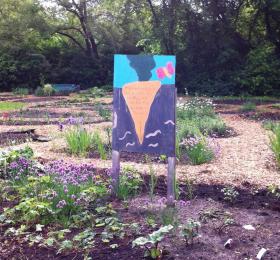City Gardener's Site
- Designated
Description of the Historic Place
The City Gardener’s Site features a portion of Victoria Park which was once the site of the Old Bone Trail, and contains the salvaged blocks from the now demolished City Gardener’s Residence and shed. This historic place is located in the King George neighbourhood, and was designated as a Municipal Heritage Property in 2014.
Heritage Value
The heritage value of the City Gardener’s Site lies in its historical association with Old Bone Trail, which passed through this area. The Old Bone Trail was used in the late 1800’s by First Nations, settlers and traders in buffalo bones. The trail was used to transport bison bones to Saskatoon and provided a route for many of the settlers to the city. It is estimated that 10,000 settlers travelled the Old Bone Trail between 1904 and 1905. Stretches of prairie trails continued to be used extensively as local roads, even after the railways arrived. Remnants of the old trails were still visible in aerial photographs taken in 1927.
The heritage value of the City Gardener’s Site also lies in its association with the city’s first gardeners. The original 1883 Saskatoon plan stated that all riverbank areas should be reserved for public use. However, in 1907, a large area of riverside land was subdivided and sold for residential and commercial development. By 1910, there were about twenty houses, businesses and outbuildings standing on what is known today as Victoria Park. In 1911 City Council decided to return the area to public use, so it acquired the buildings and had them removed – all except for the house at 707 16th Street West. This house was originally the home of William and Henry Mitten. In the backyard was an industrial plant that produced concrete blocks from 1907 to 1910. That small factory was the source of materials for several early buildings in Saskatoon.
The house went on to become home to two Superintendents of Parks and Cemeteries – and became known as the City Gardener’s Residence. From 1911 to 1954, it was home to Alfred H. Browne, known as the “Man Who Made Saskatoon Beautiful” because he was responsible for the planting of tens of thousands of trees along Saskatoon’s streets and parks. Under his direction the layout for three parks, funded by service clubs, were developed and became known as the Kiwanis, Kinsmen, and Cosmopolitan Parks.
W. J. Leonard Harvey succeeded Browne as the City Gardener in 1954. Harvey developed a classification system for parks and initiated plans that placed parks in relation to schools and population. Mr. Harvey also successfully convinced City Council to limit construction within 300 feet of the high water level on the riverbank, and thus reconfirming City Council's decision to preserve the riverbank. Harvey lived in the house until 1980.
The Gardener’s Residence was demolished in 2004, and the rear shed in 2009. Salvaged blocks from the shed were used to build three raised garden beds which are located within the footprint of the original shed. The main floor plan of the house and rooms were replicated on the ground, using salvaged blocks to delineate walls. A concrete pad and stairs outline where the old veranda and steps were located, and trails through the site mark the old driveways.
Source: City of Saskatoon Bylaw No. 9145
Character Defining Elements
Key elements which contribute to the heritage value of this historic resource include:
- The orientation and location of the salvaged blocks delineating the original footprint of the residence and shed; and
- Public access and use of the site and surrounding park space.



